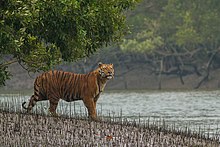Tiger attacks in the Sundarbans
 From Wikipedia - Reading time: 7 min
From Wikipedia - Reading time: 7 min
Tiger attacks in the Sundarbans, in India and Bangladesh are estimated to kill from 0-50 (mean of 22.7 between 1947 and 1983) people per year.[1] The Sundarbans is home to over 100 [2] Bengal tigers,[3] one of the largest single populations of tigers in one area. Before modern times, Sundarbans tigers were said to "regularly kill fifty or sixty people a year".[4]
These tigers are slightly smaller and slimmer than those elsewhere in India but remain extremely powerful and are infamous for destroying small wooden boats. They are not the only tigers who live close to humans; in Bandhavgarh, villages encircle the tiger reserves, and yet attacks on people are rare. Although attacks were stalled temporarily in 2004 with new precautions, they have been on the rise. This is particularly due to the devastation on the Bangladeshi side of the swamp caused by Cyclone Sidr which has deprived tigers of traditional food sources (due to the natural upheaval) and has pushed them over towards the more populated Indian side of the swamp.[5]

Precautions
[edit]The locals and government officials take certain precautions to prevent attacks. Local Hindu fishermen will say prayers and perform rituals to the forest goddess Bonbibi before setting out on expeditions. Invocations to the tiger god Dakshin Ray are also considered a necessity by the local populace for safe passage throughout the Sundarbans area. Fishermen and bushmen originally created masks made to look like faces to wear on the back of their heads because tigers always attack from behind. This worked for a short time, but the tigers quickly caught on to the ruse, and the attacks reportedly continued. One local honey gatherer, Surendra Jana, 57, summarised the general feeling of the tigers adapting to their efforts: "Before we could understand the way they attacked...We don't feel safe any more, knowing our brothers have been attacked in spite of the tricks we use."[6] Government officials wear stiff pads that rise up the back of the neck, similar to the pads of an American football player. This is to prevent the tigers from biting into the spine, which is their favoured attack method.[7]
Causes of the attacks
[edit]About 5,000 people frequent the swamps and waterways of the Sundarbans. Fishing boats traverse the area and many stop to collect firewood, honey and other items. In the dark forest, tigers find it easy to stalk and attack men absorbed in their work. Even fishermen in small boats have been attacked due to tigers' strong swimming abilities.[8]
Responses to the attacks
[edit]Local villagers, who fear tiger attacks and resent the animal for killing their livestock, sometimes engage in revenge killings. On one occasion, a tiger had attacked and wounded the people in a village in south-west Bangladesh (near the Sundarbans) and frequently preyed upon their livestock. This roused the wrath of the villagers, and the feline became a target for their retribution. Poachers are also responsible for killing tigers in the reserve in an effort to sell them on the black market.[9]
The human death rate has dropped significantly due to better management techniques and fewer people are killed each year. Even at the rate of fifty or sixty kills per year, humans would provide only about three percent of the yearly food requirements for the tiger population of the Sundarbans. Thus, humans are only a supplement to the tiger's diet; they do not provide a primary food source.[10] This does not mean that the notoriety associated with this area is unfounded. Even if only 3% of a tiger's diet is human meat, that still amounts to the tiger killing and eating about one person per year, given the amount of food a tiger typically eats.[11]
References
[edit]- ^ "Sundarban Wildlife Sanctuaries (Bangladesh)" (PDF). UNESCO World Heritage Centre.
- ^ "Only 100 tigers left in Bangladesh's famed Sundarbans forest". The Guardian. Agence France-Presse. 27 July 2015.
- ^ "Highlights: The Sundarbans, Bangladesh". Bangladesh Forest Department. Archived from the original on 1 June 2008. Retrieved 29 May 2008.
- ^ "Maneaters: The Sundarbans". lairweb. Retrieved 11 December 2013.
- ^ "Tiger attacks on rise in Indian Sundarbans". dna. IANS. 30 July 2008.
- ^ "The tiger widows of the Sundarbans". The National. Abu Dhabi Media. 13 February 2012.
- ^ Bambrick, Larry (2003). "The Last Maneater: Killer Tigers of India". Nat Geo WILD. National Geographic Channel.
- ^ "Cats! Wild to Mild: MAN-EATER?". Natural History Museum of Los Angeles County. Archived from the original on 15 July 2007.
- ^ "Villagers beat tiger to death". BBC News. 29 May 2003. Retrieved 25 May 2010.
- ^ "The tiger and lion, attacks on humans". Man-eaters.[self-published source]
- ^ Nowak, Ronald M. (1999). Walker's mammals of the world (6th ed.). Baltimore: Johns Hopkins University Press. ISBN 0-8018-5789-9.
Further reading
[edit]- Alexander, Caroline (21 April 2008). "Tigerland: A journey through the mangrove forest of Bengal". The New Yorker. Retrieved 26 January 2010.
- Ghosh, Amitav (2005). The Hungry Tide. New Delhi: HarperCollins Publishers India. ISBN 0-00-714178-5.
- Jalais, Annu (2014). Forest of Tigers: People, Politics and Environment in the Sundarbans. Routledge. ISBN 978-1-136-19869-4.</
 KSF
KSF